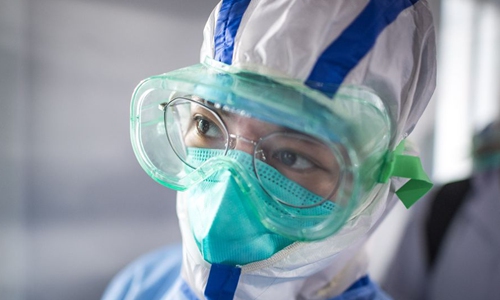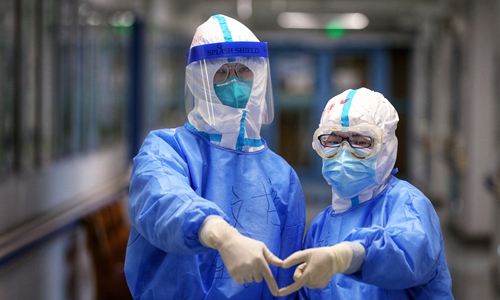HOME >> CHINA,SPECIAL-COVERAGE
Too early for optimism despite drop in new virus cases
By Liu Xin, Zhang Hui and Zhao Yusha Source:Global Times Published: 2020/2/14 12:55:33
Infection of medical staff draws public attention

A medical worker prepares to receive the first batch of patients of the novel coronavirus pneumonia at Leishenshan (Thunder God Mountain) Hospital in Wuhan, capital of central China's Hubei Province, Feb. 8, 2020. (Xinhua/Xiao Yijiu)
Daily reports of confirmed novel coronavirus pneumonia cases in Hubei, the epicenter of the outbreak, plunged on Thursday following a dramatic surge the previous day. Experts believe the shift was due to the local government's adoption of a new method to diagnose the COVID-19, which allowed hospitals to clear a backlog of suspected cases.
But the drop does not indicate an optimistic situation in Hubei as some netizens expected. Hubei still faces critical challenges with a large number of patients and pressure to prevent and control the virus, experts said.
Hubei reported 4,823 newly confirmed COVID-19 cases on Thursday, including 3,095 clinically diagnosed cases, a sudden plunge from the previous day's total of 14,840 new cases including 13,332 clinically diagnosed cases.
A suspected case will be clinically diagnosed as long as the patient shows pulmonary lesions typical of COVID-19 following a CT scan, even if they have not been given a nucleic acid test. Hubei from Wednesday began to include the number of clinically diagnosed cases in its daily updated report.
On Thursday, 116 deaths including eight clinically diagnosed cases were reported in Hubei Province, down from Wednesday's 242, including 135 clinically diagnosed cases.

Photo:Cui Meng/GT
Possible surge
Yang Gonghuan, a former vice director of the Chinese Center for Disease Control and Prevention, told the Global Times on Friday that Wednesday saw hospitals clear a backlog of suspected cases, and that Thursday's plunge showed cases were being cleared.
However, the number of confirmed cases in Hubei will not remain at previous levels of around 1,000 to 2,000, as the local government has increased health screenings of local residents, Yang said.
"A relatively high number of confirmed cases in the near future could instead offer us some relief as we know it's the result of the government's efforts to trace and control infection sources," Yang added.
Seeing the plunge in Hubei's daily reports, some netizens were excited, commenting that victory over the virus is no longer distant.
However, Yang said it is way too early to celebrate or become too optimistic as the epicenter's total number of patients has not significantly dropped and the prevention and control situation remains serious.
“Hubei may see more confirmed cases as many cities around Wuhan that also face a severe epidemic situation would include clinically diagnosed cases. Compared to Wuhan, these cities have inadequate medical resources and they will face more pressure in receiving more patients,” Yang Zhanqiu, deputy director of the pathogen biology department at Wuhan University, told the Global Times.
For example, Huanggang and Xiaogan, two cities located less than 100 kilometers away from Wuhan, have a large number of residents working in Wuhan. Hubei officials did not give enough attention to the COVID-19 prevention in villages in the two cities, which made them another severely affected areas aside from Wuhan, Yang noted.
Xianning reported 200 new confirmed cases, Huanggang 162 and Xiaogan 135 on Thursday, as the top three in new confirmed cases in Hubei outside Wuhan.
The Xiaogan government announced on Thursday that the city would update its preventive measures, including taking all patients with fever to hospital, checking for people with close contacts with Wuhan, and taking close-off managements on all residential communities. Huanggang also announced similar close-off management measures on Thursday.
Yang noted that Wuhan and other cities in Hubei are strengthening efforts to check suspected cases. The basic information about patients may be clear within the week.
“If the suspected cases and confirmed cases, including the clinically diagnosed cases, will decrease, that means the epidemic has been under control. Otherwise, the situation has not improved,” Yang said.
Chen Yixin, who was recently appointed deputy head of a central government group to guide the epidemic control work in Hubei Province, said on Tuesday that the total number of infections in Wuhan has not been fully identified and the number of people being newly infected may still be relatively large.
Yang also suggested the Hubei government adopt a new daily report methodology, reporting the numbers based on the time when patients begin to show symptoms rather than when they are diagnosed, to better assess the effectiveness of the government's preventive and control measures.
Pressure on medical staff
Although thousands of medical staff across China have come to support Wuhan and Hubei, there may still be a shortage of doctors especially on respiratory medicine and critical care medicine, Yang said, noting that more confirmed cases being taken in hospitals in Wuhan and Hubei may increase pressure on medical staff battling the virus on the frontline.
A doctor surnamed Yuan in Huangmei county, Huanggang, which has 2,228 people infected as of Friday, said that he hasn’t gone back home for almost a month. According to Yuan, his hospital has extended the opening time for the fever clinic to 24/7. A majority of the hospital personnel were required to be on duty in this clinic. “As the number of suspected infection cases surges every day, we now face a huge gap in medical supplies. Sometimes we use garbage bags to wrap our boots,” said Yuan, noting that he now lives in the hospital as all medical workers are required to be placed under quarantine.
Chen Ying, who is a nurse in a hospital in Huangmei, told the Global Times that the nurses are required to measure the body temperatures of the family members of those infected. They are also asked to answer questions online from villagers in neighboring villages, and inform them on how to protect themselves from the virus.
The infection of medical staff has also drawn public attention. Zeng Yixin, deputy director of the National Health Commission (NHC), told a press conference on Friday that as of Tuesday midnight, there were 1,716 medical staff infected with COVID-19, accounting for 3.8 percent of confirmed cases nationwide. Six of them have died. Hubei had 1,502 medical staff infected, and Wuhan had 1,102.
Zeng noted on Friday that authorities have asked governments on all levels to strengthen protection of medical staff, requiring medical staff in Hubei to change shifts to rest.
The Ministry of Finance and Ministry of Human Resources and Social Security would offer allowances to medical staff working on the frontline to battle the virus – 300 yuan ($43) and 200 yuan each day in accordance to the level of risk.
According to data from the NHC, as for Wednesday, 189 medical teams with 21,569 medical staff had come to support Hubei.
There was also some encouraging news on the current epidemic situation in China on Friday. Outside Hubei, 267 new confirmed cases were reported on Thursday while it was 890 on February 3, a decline in 10 consecutive days.
Mi Feng, NHC spokesperson, told a press conference on Friday that the decline showed an effective prevention, and more work should be done to cement the results.
Posted in: SOCIETY,FOCUS